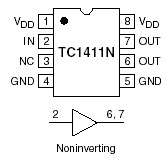Features: • Latch-Up Protected: Will Withstand 500mA Reverse Current
• Input Will Withstand Negative Inputs Up to 5V
• ESD Protected: 4kV
• High Peak Output Current: 1A
• Wide Operating Range
- 4.5V to 16V
• High Capacitive Load Drive Capability: 1000pF in 25nsec
• Short Delay Time: 30nsec Typ.
• Consistent Delay Times With Changes in Supply Voltage
• Matched Delay Times
• Low Supply Current
- With Logic "1" Input: 500µA
- With Logic "0" Input: 100µA
• Low Output Impedance: 8Ω
• Pinout Same as TC1410/TC1412/TC1413Application• Switch Mode Power Supplies
• Pulse Transformer Drive
• Line Drivers
• Relay DriverPinout
Specifications| Power | Single |
| Peak Output Current (mA) | 1000 |
| Output Resistance (RH/RL)(Max. @ 25°C) | 11/11 |
| Max. Supply Voltage (V) | 16 |
| Input/Output Delay (td1, td2)1 (ns) | 40/40 |
| Configuration | Non-Inverting |
| Description | Low-side MOSFET Drivers, 0.5A to 1.2A Peak Output Current |
| Operating Temp. Range (°C) | -40 to 85 |
| Power |
Single |
| Peak Output Current (mA) |
1000 |
| Output Resistance (RH/RL)(Max. @ 25°C) |
11/11 |
| Max. Supply Voltage (V) |
16 |
| Input/Output Delay (td1, td2)1 (ns) |
40/40 |
| Configuration |
Non-Inverting |
| Description |
Low-side MOSFET Drivers, 0.5A to 1.2A Peak Output Current |
| Operating Temp. Range (°C) |
-40 to 85 |
Supply Voltage........................................................ +20V
Input Voltage......................... VDD + 0.3V to GND 5.0V
Power Dissipation (TA 70°C)
PDIP .................................................................... 730mW
SOIC..................................................................... 470mW
Package Thermal Resistance
PDIP RJ-A..........................................................125°C/W
PDIP RJ-C........................................................... 42°C/W
SOIC RJ-A ........................................................ 155°C/W
SOIC RJ-C .......................................................... 45°C/W
Operating Temperature Range
C Version..........................................................0 to +70
E Version ..................................................... -40 to +85
Storage Temperature Range ..................... -65 to +150
*Stresses above those listed under "Absolute Maximum Ratings" may cause permanent damage to the device. These are stress ratings only and functional operation of the device at these or any other conditions above those indicated in the operation sections of the specifications is not implied. Exposure to Absolute Maximum Rating conditions for extended periods may affect device reliability.DescriptionThe TC1411/1411N are 1A CMOS buffer/drivers. They will not latch up under any conditions within their power and voltage ratings. They are not subject to damage when up to 5V of noise spiking of either polarity occurs on the ground pin. They can accept, without damage or logic upset, up to500mA of current of either polarity being forced back into their output. All terminals are fully protected against up to 4kV of electrostatic discharge. As MOSFET drivers, the TC1411/1411N can easily switch 1000pF gate capacitance in 25nsec with matched rise and fall times, and provide low enough impedance in both the ON and the OFF states to ensure the MOSFET's intended state will not be affected, even by large transients. The rise and fall time edges are matched to allow driving short-duration inputs with greater accuracy.
The TC1411/TC1411N are 1A CMOS buffer/drivers.
They will not latch up under any conditions within their power and voltage ratings. They are not subject to damage when up to 5V of noise spiking of either polarity occurs on the ground pin. They can accept, without damage or logic upset, up to 500mA of current of either polarity being forced back into their output. All terminals are fully protected against up to 4kV of electrostatic discharge. As MOSFET drivers, the TC1411/TC1411N can easily charge a 1000pF gate capacitance in 25nsec with matched rise and fall times, and provide low enough impedance in both the ON and the OFF states to ensure the MOSFET's intended state will not be affected, even by large transients.
The rise and fall time edges are matched to allow driving short-duration inputs with greater accuracy.

 TC1411N Data Sheet
TC1411N Data Sheet








